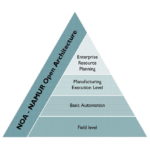The idea of communication via wireless networks has been propagated within the industry for years. In particular in process engineering, however, Bluetooth, WLAN, and various proprietary transmission technologies have only been able to open up a few individual special applications. Even the WirelessHart standard has not been able to make a successful breakthrough, despite relatively high transmission reliability. For many users, establishing this network, developed especially for process automation, appeared to be too expensive and complex to be used merely to perform monitoring and optimisation tasks. Professional asset monitoring can, however, save considerable resources and significantly increase system reliability and efficiency. Unfortunately, the expenditure needed to make the necessary data usable was high. This is changing due to digitalisation and the associated approaches, such as Namur Open Architecture (NOA), that extend existing automation structures through open interfaces. The associated information models such as PA-DIM (Process Automation – Device Information Model) allow device and diagnostic data to be acquired through a second communication channel and be made available in standardised form to an application, for example a web-based asset management system.
Common infrastructure
Can 5G be used for this – more successfully than previous cellular communication technologies? 5G technology is ideal for establishing private networks. Moreover, 5G is a full-fledged communications infrastructure that also opens up a range of services. In contrast to WLAN, it is possible to assign resources and distribute priorities to the participants within a 5G network. 5G allows different applications, for example, simple condition monitoring, critical function monitoring, and also controlling automated guided vehicle systems, to be operated within this one communication infrastructure. A low data rate and, at the same time, low priority are normally necessary as part of condition monitoring. Emergency shower monitoring requires even lower data rates, whereas the priority here is very high. In contrast, controlling automated guided vehicle systems that are equipped with cameras requires a very high bandwidth which, however, does not necessarily correlate with the priority.
The critical difference in comparison to all previous wireless technologies is the fact that all of these applications can be realised with 5G transmission via a shared infrastructure. Any investments made in such infrastructure will normally be returned very quickly if several different applications are realized effectively. Such an orchestrated network topology supports system and device monitoring and optimisation, which NOA is targeting within an open system environment and which has a significantly lower priority than the core automation. In principle, however, it is possible to develop 5G technology so that it can also be used in the core process. This is due to the fact that due to prioritisation, data transmission can be realised as a part of highly available applications. In addition to the emergency shower safety application, there may be production-relevant applications in which the failure of communication would result in the loss of valuable products or the danger of explosions.
Different systems in test
This is still very much in the future. But there is no question that 5G is already making waves in the process industry today. In some pilot projects, operators are developing private 5G networks to test the announced properties of the new mobile communications standard. In an extensive chemical park or an integrated site, the application possibilities can be diverse, which tends not to be the case in numerous medium-sized companies in the process industry. However, 5G picocell networks, already in existence with 4G technology, will also be possible for such companies in the medium term, for example for forwarding sensor data for monitoring and optimisation applications. Particularly in the brownfield sector, systems equipped with cost-effective additional sensors for monitoring and optimization (M&O) in the non-Ex area could achieve significant productivity gains with the additional connectivity. Currently, the costs for medium-sized businesses to establish a private 5G network are high. This is also true of sensors for potentially explosive areas. Equipping every M&O sensor with 5G will therefore also be too expensive. However, intelligence is moving ever-closer to the field level. With this development, the data from existing and additional field devices (brownfield/greenfield) could also be collected, preprocessed, and standardised (NOA-compliant) using a decentral control system. This standardised data can then be transmitted wirelessly to higher-level asset management systems or to the cloud via 5G routers. It will also be possible very soon to equip certain areas of a site, for example a tank storage facility, with a 5G edge gateway. M&O sensor data can be transferred there via cable and forwarded by the gateway to a cloud solution or an asset management system wirelessly.
Releases to meet user requirements
There is still a fair amount of development work to be done. The 5G devices currently available are based on release 15 of the standard published in December 2018. Release 16, published in the fall of 2020, focuses on IoT application scenarios – with massive Machine Type Communication (mMTC) that supports a large number of connections with relatively low data rates. Additional applications with the focus on reliability and lower latencies will be covered by release 17 – ultra-Reliable and Low Latency Communication (uRLLC). This specification is scheduled for publication at the end of 2021. It will then, however, be a few years before modules and devices are also available for such applications. However, it can be expected that the first pilot users will be capable of realising the applications outlined above, from emergency shower to M&O data collection, through big data analyses, all the way to AGV control within a prospective timeframe of just four to five years.
Applications as part of maintenance are obvious. An example is the digital rating plate that maintenance technicians can access in the field using their tablets. Technical details on a device, repair instructions, and short explanatory videos will then be available for every asset so equipped. The constantly networked “mobile workers” will be significantly more productive – and their work much more failsafe. Augmented reality will be available to them in the plant with the help of the 5G mobile network, which will allow a distant expert to virtually “look over their shoulder” using the camera in the handheld tool to provide them with remote support.
Setup of virtual private networks
The models for 5G industrial networks differ from those of public cellular networks. For example, a guaranteed Quality of Service (QoS) as well as structured communication within QoS classes will be of significant importance. The fully isolated private 5G network is just one possible option. Not every user will be able or willing to raise the associated resources necessary for participation. Intermediate stages, in which a campus network is connected to the public network, can also be realised. The management of devices, for example the administration of the participants, could be performed in the public area by the provider, but the data traffic would only be transmitted locally in the campus network.
Virtual private networks, of which rudimentary versions are already available via private APNs (Access Point Name) in the 4G network, will also be available with 5G. They will be enhanced by “network slicing” in the 5G standard: the network of the future can meet individually fluctuating demand for data rates, speed, and capacities by making part of the public network virtually available to the user. Such scenarios will be of interest to smaller companies in particular, allowing them access to sufficient resources at all times through a service level agreement with their provider.
Further questions must be answered
The frequency assignments for local 5G networks to companies show just how great the interest is. Numerous industrial companies, including Mercedes-Benz, Audi, and BMW, are involved and have signed up to the publication on the German Federal Network Agency website. Evonik Industries is also included as a representative of the process industry. Others, such as BASF, are also actively involved. Phoenix Contact emphasises the benefits of shared experience; the company is also one of the frequency allocation holders. Phoenix Contact is setting up a local network in its own production facilities, in part as a basis for concrete discussions on 5G with representatives of the process industry.
Before the new cellular standard can be widely used in the process industry, however, many detailed questions still need to be answered, among them the issue of explosion protection. Previous protection concepts and technical rules are not sufficient to ensure safe operation in potentially explosive areas. Research cooperations, such as between the PTB and the Ex-Network e.V., are already working on safety-relevant assessments to avoid potential ignition sources.
Phoenix Contact GmbH, Blomberg, Germany
Author: Wilfried Grote
Director Industry Management Chemicals and Pharmaceuticals,
Phoenix Contact Electronics















